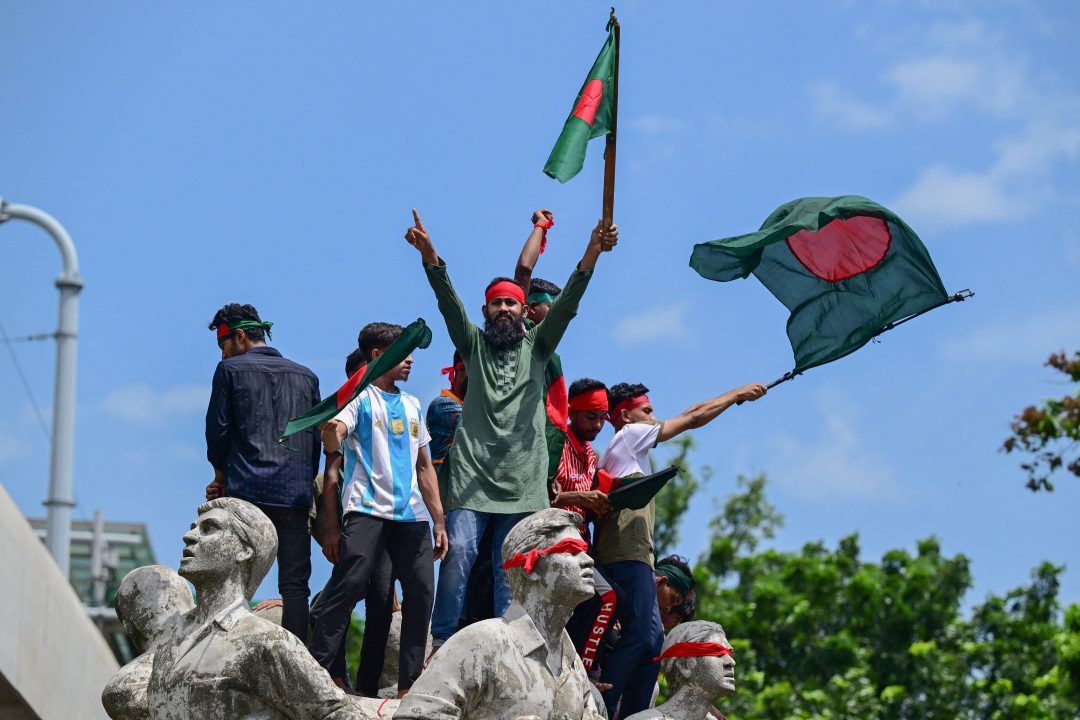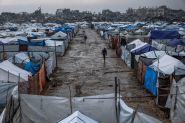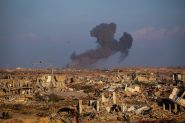- Home
- Middle East
- How Bangladesh's Student Protests Overthrew the Government

©Munir UZ ZAMAN / AFP
Protests in Bangladesh that began as student-led demonstrations against government hiring rules have spiralled into violence killing more than 280 people and overthrowing the premiership of Prime Minister Sheikh Hasina.
Here are six key dates spanning the protests that ended the autocratic 15-year rule of 76-year-old Prime Minister Sheikh Hasina, leader of the South Asian nation of 170 million people.
University students build barricades blocking roads and railway lines to demand reforms of a quota system for sought-after public sector job hires.
They say the scheme is used to stack the civil service with loyalists of Hasina's ruling Awami League.
Hasina, who won a fifth term as prime minister in January after a vote without genuine opposition, says the students are "wasting their time".
The first recorded deaths include six people killed in clashes, a day after bitter violence erupted when protesters and pro-government supporters in Dhaka fought with sticks and hurled bricks at each other.
Hasina's government orders the nationwide closure of schools and universities.
Students reject an olive branch from Hasina, a day after she appeals for calm and vows that every "murder" in the protests would be punished.
Protesters chant "down with the dictator" and torch the headquarters of state broadcaster Bangladesh Television and dozens of other government buildings.
The government imposes an internet blackout.
At least 32 people are killed and hundreds are injured in clashes, which continue in the following days despite a round-the-clock curfew and the deployment of soldiers.
Bangladesh's Supreme Court, seen by critics as a rubber stamp for the will of Hasina's government, rules the decision to reintroduce job quotas was illegal.
But its verdict falls short of protester demands to entirely abolish job reservations for children of "freedom fighters" from Bangladesh's 1971 independence war against Pakistan.
Hundreds of thousands of Bangladeshi protesters clashed again with government supporters on Sunday. Police say at least 14 officers are among the 77 killed.
But in a stiff rebuke to Hasina, influential ex-army chief General Ikbal Karim Bhuiyan calls on the government to withdraw troops from the streets and condemns "egregious killings".
That followed comments by current army chief Waker-uz-Zaman, who said the armed forces "always stood by the people", without giving more details.
[readmore url="https://thisisbeirut.com.lb/world/279214"]
Leaders of the nationwide civil disobedience campaign called on supporters to march on the capital Dhaka on Monday for a "final protest".
Sheikh Hasina's 15-year rule came to an end when she fled the country by helicopter, shortly after protesters stormed her palace in Dhaka.
Soldiers and police with armoured vehicles in Dhaka had barricaded routes to Hasina's residence with barbed wire on Monday morning, but vast crowds flooded the streets, tearing down barriers.
Jubilant crowds had waved flags, some dancing on top of a tank in the streets before hundreds broke through the gates of Hasina's official residence.
Bangladesh's army chief Waker-Uz-Zaman said Monday he would "form an interim government", and had held talks with the main opposition parties and civil society members -- but not Hasina's Awami League.
With AFP
Here are six key dates spanning the protests that ended the autocratic 15-year rule of 76-year-old Prime Minister Sheikh Hasina, leader of the South Asian nation of 170 million people.
July 1: Blockades Begin
University students build barricades blocking roads and railway lines to demand reforms of a quota system for sought-after public sector job hires.
They say the scheme is used to stack the civil service with loyalists of Hasina's ruling Awami League.
Hasina, who won a fifth term as prime minister in January after a vote without genuine opposition, says the students are "wasting their time".
July 16: Violence Intensifies
The first recorded deaths include six people killed in clashes, a day after bitter violence erupted when protesters and pro-government supporters in Dhaka fought with sticks and hurled bricks at each other.
Hasina's government orders the nationwide closure of schools and universities.
July 18: PM Rebuffed
Students reject an olive branch from Hasina, a day after she appeals for calm and vows that every "murder" in the protests would be punished.
Protesters chant "down with the dictator" and torch the headquarters of state broadcaster Bangladesh Television and dozens of other government buildings.
The government imposes an internet blackout.
At least 32 people are killed and hundreds are injured in clashes, which continue in the following days despite a round-the-clock curfew and the deployment of soldiers.
July 21: Supreme Court Verdict
Bangladesh's Supreme Court, seen by critics as a rubber stamp for the will of Hasina's government, rules the decision to reintroduce job quotas was illegal.
But its verdict falls short of protester demands to entirely abolish job reservations for children of "freedom fighters" from Bangladesh's 1971 independence war against Pakistan.
August 4: Army Stands with the People
Hundreds of thousands of Bangladeshi protesters clashed again with government supporters on Sunday. Police say at least 14 officers are among the 77 killed.
But in a stiff rebuke to Hasina, influential ex-army chief General Ikbal Karim Bhuiyan calls on the government to withdraw troops from the streets and condemns "egregious killings".
That followed comments by current army chief Waker-uz-Zaman, who said the armed forces "always stood by the people", without giving more details.
[readmore url="https://thisisbeirut.com.lb/world/279214"]
Leaders of the nationwide civil disobedience campaign called on supporters to march on the capital Dhaka on Monday for a "final protest".
August 5: The Palace Is Stormed, and the Regime Falls
Sheikh Hasina's 15-year rule came to an end when she fled the country by helicopter, shortly after protesters stormed her palace in Dhaka.
Soldiers and police with armoured vehicles in Dhaka had barricaded routes to Hasina's residence with barbed wire on Monday morning, but vast crowds flooded the streets, tearing down barriers.
Jubilant crowds had waved flags, some dancing on top of a tank in the streets before hundreds broke through the gates of Hasina's official residence.
Bangladesh's army chief Waker-Uz-Zaman said Monday he would "form an interim government", and had held talks with the main opposition parties and civil society members -- but not Hasina's Awami League.
With AFP
Read more




Comments